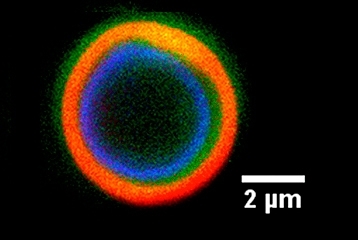

Study by Brazilian scientists describes action of galectin-3 in modulating immune response to cryptococcosis. Results were published in Nature Communications (image: release)
Study by Brazilian scientists describes action of galectin-3 in modulating immune response to cryptococcosis. Results were published in Nature Communications.
Study by Brazilian scientists describes action of galectin-3 in modulating immune response to cryptococcosis. Results were published in Nature Communications.

Study by Brazilian scientists describes action of galectin-3 in modulating immune response to cryptococcosis. Results were published in Nature Communications (image: release)
By Maria Fernanda Ziegler | Agência FAPESP – People with impaired immunity, such as patients with AIDS or undergoing chemotherapy, frequently suffer from cryptococcosis, a fungal infection caught by inhaling pigeon (or other bird) droppings contaminated with the encapsulated yeast Cryptococcus neoformans. It can result in pneumonia and meningoencephalitis (inflammation of the meninges and brain).
Although the disease is one of the most important fungal infections in Brazil, conventional treatment with a drug in use for over 50 years is slow compared with treatment of bacterial infections and is not very effective. It is estimated that 30% of patients do not respond to treatment, which can last up to two years.
A new study has now opened up an array of possibilities for the development of novel treatments for cryptococcosis. The researchers discovered that the protein galectin-3, present in humans and other animals, contributes to the host’s defense against infection by C. neoformans.
The study, published in Nature Communications and supported by FAPESP, compared the severity of the disease in galectin-3-deficient mice and wild-type mice.
“Galectin-3 influenced the immune response by regulating the host’s defense against the fungus. We found that the protein induced fungal vesicle lysis [destruction] by rupturing the membranes of the extracellular vesicles that export fungal molecules,” said Fausto Almeida, a researcher in the Biochemistry & Immunology Department of the University of São Paulo’s Ribeirão Preto Medical School (FMRP-USP) in Brazil.
The study is the first to describe the role of galectin-3 in cryptococcosis. Previous studies addressed other actions of the protein, such as in homeostasis or tumor cells. The authors highlight a peculiarity of galectin-3, which is that it can be beneficial to the host or to the agent depending on certain factors. “Its action changes significantly depending on the type of infection and the type of pathogen,” Almeida said.
C. neoformans is an important model for research in cellular biology. It produces extracellular vesicles containing key virulence factors. Vesicles secreted by the fungus are released from the cell membrane and pass through the cell wall to reach the extracellular space, facilitating the delivery of fungal molecules to the host’s tissues.
The FMRP-USP group observed high levels of the protein in the blood of patients with cryptococcosis admitted to Ribeirão Preto’s general and teaching hospital (Hospital das Clínicas). “This suggested a link of some kind between the protein and the immune system acting against the disease,” Almeida said.
The group then conducted an experiment in which infected mice were found to have augmented levels of galectin-3 not only in their blood but also in their brain, lung and spleen tissue. Galectin-3-deficient mice were more susceptible to the infection than control mice.
“Our analysis showed that fungal burden was higher in galectin-3-deficient mice, leading to a lower survival rate,” Almeida said.
Regulating immune response
After analyzing the action mechanism of galectin-3, the researchers focused on the protein’s role in regulating the host’s immune response.
“Galectin-3 inhibits fungal growth and reduces the stability of the extracellular vesicles that transport the biological material required by the fungus to establish infection in the host,” Almeida explained. “The exported molecules direct the pathogenesis of the infection, but galectin-3 plays the immunomodulatory role.”
By breaking through the vesicle membrane, the protein helps the host’s immune system detect the infection. “We’re still investigating how beneficial this lysis may be. While vesicle lysis recognizes infection so that the fungus can be combated, at the same time, it can lower the host’s immunity and heighten the infection,” Almeida said.
“However, when we analyzed macrophages without galectin-3, absorption of these vesicles was far lower. The role of galectin-3 is to recognize the infection as a result of vesicle lysis and then direct the immune response.”
The Nature Communications article “Galectin-3 impacts Cryptococcus neoformans infection through direct antifungal effects” (doi: 10.1038/s41467-017-02126-7) by Fausto Almeida, Julie M. Wolf, Thiago Aparecido da Silva, Carlos M. DeLeon-Rodriguez, Caroline Patini Rezende, André Moreira Pessoni, Fabrício Freitas Fernandes, Rafael Silva-Rocha, Roberto Martinez, Marcio L. Rodrigues, Maria Cristina Roque-Barreira and Arturo Casadevall can be read at: nature.com/articles/s41467-017-02126-7.
Republish
The Agency FAPESP licenses news via Creative Commons (CC-BY-NC-ND) so that they can be republished free of charge and in a simple way by other digital or printed vehicles. Agência FAPESP must be credited as the source of the content being republished and the name of the reporter (if any) must be attributed. Using the HMTL button below allows compliance with these rules, detailed in Digital Republishing Policy FAPESP.





